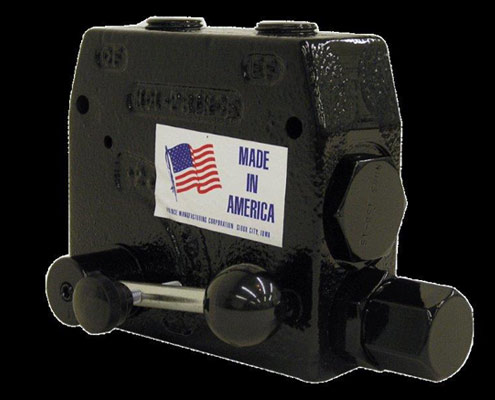
Flow control valves, such as the Prince valve, help with pressure compensation. This valve from Prince Manufacturing is a pressure compensated adjustable flow control valve. By rotating the handle, the flow out the “CF,” or controlled flow port, can be varied from approximately 0 to the maximum controlled flow allowed. Any remaining flow is bypassed to the “EF” or excess flow port. This flow can be used to power another circuit or can be returned to tank. Once the controlled flow is set it will remain nearly constant with variations in pressure on either the controlled or excess flow ports.
You’ve been around hydraulics a while, haven’t you? With that in mind, you probably take some things for granted. There is plenty of jargon in our industry, and it isn’t learned overnight. However, if you were like me, the term pressure compensation was difficult to grasp early in your hydraulic career. If you still don’t quite get it, here’s a quick explanation of pressure compensation.
Fluid flows through components and plumbing at a rate dictated by pressure potential. If you measure pressure at point A close to your pump, and also at point B at your actuator, the difference in those two pressures is the energy available for the fluid to literally get from point A to point B. The higher this difference, the more energy there is for flow to take place. The closer point B pressure is to point A pressure, the less flow potential can take place. In hydrodynamic applications, you lose the ability to achieve velocity in your actuators because of the energy lost to flowing.
With positive displacement systems like hydraulics, which we call hydrostatics, it’s the physical force applied from the pump that pushes the oil like a physical rod. It’s literally force transfer occurring, rather than energy being contained in the inertia of the fluid moving. In this case, if fluid is pumped through one passageway, flow is not affected by pressure differential between point A and point B, except in what is lost to leakage. I should note leakage rates increase as pressure increases, but the same can occur in hydrodynamic applications.
The problem with changes in pressure at point B, is that it changes pressure differential between it and point A. This pressure differential is critical to dictate flow rates, especially when metering of fluid rate is employed. If point A is a constant 3,000 psi, and your orifice is 0.140 in., you will flow about 26 gpm. With no other changes but adding a load from a downstream motor that uses 2,000 psi flow suddenly drops to just over 15 gpm with only 1,000 psi left for flow potential (the difference between point A and point B). The rest of the 11 gpm being created by the pump would then go over the relief valve.
If you change your orifice to a pressure compensated metering valve and set it to flow about 26 gpm at 3,000 psi, it will do exactly that … always. When you run your motor using 2,000 psi of work pressure, you’re still only left with 1,000 psi to move fluid through the metering valve. Only this time, the valve self-pilots open to increase its effective diameter closer to 0.185 in., which is enough to flow 26 gpm at 1,000 psi. The valve compensates for changes in downstream pressure by opening and closing to increase or decrease its orifice.
Essentially, pressure compensation is when a hydraulic component can ready load or system pressure and adjust itself to make up for changes in those pressures. It could be a pressure compensated pump which reduces flow when downstream pressure rises too high, or a pressure compensated flow control which increases flow potential when downstream pressure rises.
Filed Under: Mobile Hydraulic Tips, Slider, Valves & Manifolds